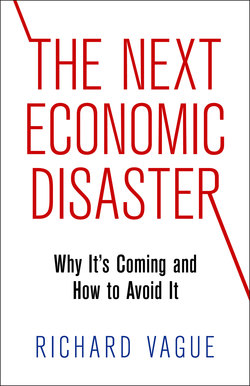Читать книгу The Next Economic Disaster - Richard Vague - Страница 5
ОглавлениеThe US economy is elbowing its way to recovery. In fact, booms have returned to some pockets of the economy. Unemployment is still painfully high but is coming down. The stock market is at historic highs. The rest of the world is struggling back as well.
There is one statistic that could return the global economy to the terrible old days of 2007–2008. It is one I learned about during my thirty years in banking, much of that time spent as cofounder, president, and then CEO of one of the nation’s largest consumer lenders. Although my bank did not make mortgage loans, from my ringside seat to the lending industry, I saw the massive increase in mortgage loans starting in the early 2000s that helped make me an expert on an underrecognized yet critical economic indicator: private debt. That might sound esoteric, but it’s crucially important. This one element in the economy is responsible for the financial crisis of 2008 and will precipitate the next one if it goes unheeded.
The idea that private debt can accumulate to the point that it is harmful comes from the very beginnings of civilization. On some occasions when debt had increased to high levels, rulers in places like ancient Egypt, Babylon, and Israel canceled debts of the people and gave them a clean slate.
Closer to home, between 2001 and 2004, US household mortgage debt increased a mind-boggling 48 percent. I worried that the inevitable bad loans from this mortgage tsunami could engulf our business as well. So I asked industry economists about it, only to hear that since the value of consumer homes and stock holdings had increased more than mortgage loans, there was no cause to worry. As a lender, I knew that even if that were true, consumers would have to sell assets to pay back their now significantly higher levels of debt, and that meant our industry was in for terrible problems. It did not matter that I was not in that particular business. Just as a rising tide lifts all boats, a tsunami overwhelms everyone. We were all going down with the ship.
And so we did. By 2007, this same mortgage debt had increased by an unthinkable 99 percent in just six years, and the financial industry was soon overwhelmed by the greatest crisis since the Great Depression. Some perished. It is a miracle that anyone survived.
There were many arguments over who and what were to blame. As it became clear to me that the frenetic growth of private loans was the culprit, I wondered whether rapid loan growth was the cause of other epochal crises—such as the Great Depression and the Japan Banking Crisis of 1991. And if so, was private debt the only cause, or were there other factors? If I answered those questions, could we realistically predict and prevent future crises?
Before I could begin to look for answers, the debate was hijacked by loud voices invested in moving the debate over to government debt and a very different and rancorous discussion of “austerity vs. stimulus.” Despite the noise, I conducted my own investigation of these issues, hiring a team of economists as part of the effort. When we started to dig in, we found that data and analysis of private debt were not as readily available as we would have thought, particularly outside the United States, so we set out to gather and analyze that data ourselves.
The results were eye-opening.
In fact, they were so unexpected that I took the further step of visiting with dozens (and dozens) of different economists with a broad spectrum of viewpoints to get their sense of my findings. The reactions ranged from rejection to enthusiasm, but they were always instructive. I retained a second group of economists to poke holes in the findings of the first team. I listened carefully. This book is the result of all that work. It tells the story of past crises (as opposed to mere recessions), a prediction of a looming crisis we may collectively face, and an analysis of the paradox of debt itself.
Lurking underneath is a deeper concern about the long-term trend line of private debt in our nation and the world. Private debt has grown faster than income and GDP (gross domestic product, a measure of the size of a country’s economy) for a very long time—going back two hundred years, in fact. A high level of private debt makes an economy more vulnerable to crises and impedes stronger growth. So continuing this trend will assuredly bring escalating problems. Whatever else it is, this book is my modest contribution to a debate about the central role of private debt in economic trends and the wisdom of changing the global course from its current, perilous path.
